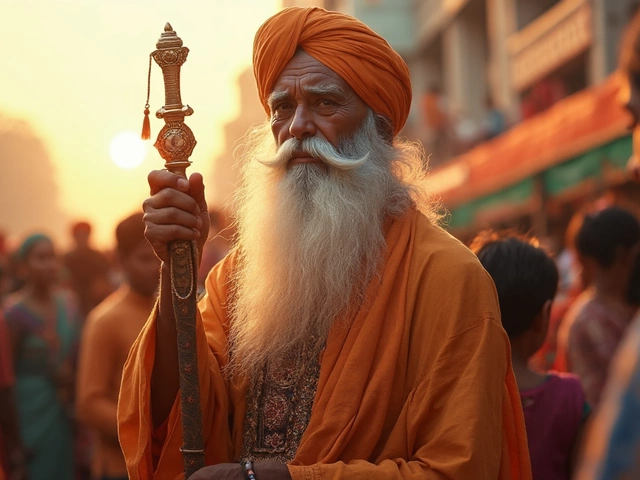The Kirpan isn't just a piece of history or a religious artifact—it's a living symbol of justice and responsibility. Ever seen a Sikh carrying one and wondered why? It’s not for decoration or to flash around at gatherings. The Kirpan has a story, a purpose, and it's deeply woven into the Sikh identity.
So, what’s the deal with the Kirpan? It dates back to the founding of the Sikh faith in the 15th century, around the time Guru Gobind Singh established the Khalsa, a group committed to living truthful lives, defending the downtrodden, and upholding justice. Back then, it was a functional weapon. But it wasn't about aggression—it was about protection. It stood for the responsibility to safeguard others, not just oneself.
Fast forward to today, and you’ll still see Sikhs wearing the Kirpan. They wear it not as a mark of prestige but as a reminder of their duty to the community and the world at large. It remains a spiritual metaphor—a testament to a promise that Sikhs make to live as protectors and defenders against injustice, treating inequality with zero tolerance.
- Origins and Historical Significance
- Symbolism and Meaning
- Modern-day Practice
- Global Perceptions and Challenges
Origins and Historical Significance
To truly get why the Kirpan matters, you need to travel back to the times of Guru Nanak, the founder of Sikhism, and the Sikh gurus who followed him. The 15th century wasn’t exactly a peaceful stroll through history—there were a lot of social and political upheavals. During these times, the idea of the Kirpan took root.
Guru Gobind Singh, the tenth Sikh Guru, plays a massive role in the story of the Kirpan. At the Vaisakhi festival in 1699, he formed the Khalsa, a brotherhood dedicated to the purity of faith and defense of the oppressed. Each member was instructed to carry a Kirpan, not as a weapon of aggression but as a symbol of dignity, self-respect, and readiness to help anyone in need.
Interestingly, the word "Kirpan" originates from the words "kirpa," meaning mercy or grace, and "aan," meaning honor. This blend shows how deeply the concept is rooted in values of righteousness and protection rather than any call for violence. The Kirpan represents both a spiritual commitment and a historical duty to stand against tyranny and injustice, transcending time as a reminder of this pledge.
The British Raj and later socio-political movements put the Kirpan symbol through various tests. The British attempted to regulate its use, but Sikhs stood firm on its significance, viewing it as part of their identity and faith, rather than as a mere accessory. Today, debates continue in different parts of the world regarding its practicality, yet its role in Sikh history as an emblem of justice remains unshaken.
Symbolism and Meaning
The Kirpan is more than just a ceremonial dagger; it embodies core values of Sikhism. Worn as a constant reminder, it signifies a profound commitment to justice, compassion, and responsibility. It's not merely about defense; it's a pledge to stand against tyranny and help those in need.
Let's talk about the roots. The word 'Kirpan' itself is derived from two words: 'Kirpa,' which means mercy or grace, and 'Aan,' which signifies honor or dignity. This combination underlines the balance Sikhs must maintain between humility and honor as they fight against injustice.
Interestingly, the Kirpan isn't intended as a weapon of violence. It's often small and symbolic in size, representing a moral responsibility. Sikh teachings emphasize that it should remain sheathed—the notion here being that its presence is more about intention than action.
Spiritual Duties
Carrying a Kirpan is part of the 'Five Ks'—the five articles of faith that baptized Sikhs are required to wear. By carrying a Kirpan, Sikhs commit to upholding the dignity and self-respect of themselves and others. It's an emblem of courage for doing the right thing, even when it's hard.
Everyday Significance
On a daily basis, the Kirpan inspires Sikhs to reflect on their duties both spiritually and socially. It's a call to action to be proactive in their communities, providing relief to those in distress. Some modern Sikhs might wear a miniature version, making it practical to fulfill this religious duty while respecting contemporary social norms.
Symbol in Modern Times
Amidst cultural shifts and rising global awareness, the Kirpan still commands respect among Sikhs globally. Despite challenges, it remains an unyielding testament to one's faith and a tool for fostering a world where justice and mercy are not mere words but lived values. This small dagger has a unique story—one that continues to be relevant even as history unfolds.

Modern-day Practice
In today’s world, the Kirpan remains a significant part of Sikh life, symbolizing both faith and duty. You might spot Sikhs carrying them wherever you go—from local parks to bustling city centers. But here's the thing: it's not just a religious symbol, it’s a way of life.
Now, let's get real. We live in a world where security is a big deal, and carrying what looks like a weapon can trigger alarms. Yet, Sikh communities have been actively engaging in dialogues to ensure the Kirpan is understood and respected, working with law enforcement and policymakers to find common ground. In countries like Canada and the UK, there are legal allowances for Sikhs to carry the Kirpan—a big win for religious freedom.
Integration in Daily Life
So, how does it work with the Kirpan in day-to-day life? For many Sikhs, it’s about discretion and respect. They're usually worn under clothing, in a sheath, often on a strap that crosses the chest. It's not about displaying it for attention; it's about having it as a constant reminder of their commitments.
Take educational settings for example. Schools and universities have adapted their policies, permitting the Kirpan as long as it doesn’t pose a threat. It’s a delicate balance between religious liberty and safety, and it’s working more often than not.
Tackling Misconceptions
One of the biggest challenges? Clearing up misconceptions. Some folks misunderstand the Kirpan as a weapon rather than a symbol of faith. This is why education is key. There are workshops and community events aimed at spreading awareness about the Kirpan, explaining its significance and reassuring the public.
Global Perspectives
Worldwide, the acceptance of the Kirpan varies. In the U.S., courts have tackled cases on its carry rights, often siding with religious rights. Meanwhile, countries like France have strict laws limiting religious symbols in public, creating challenges for Sikhs there. It's a mixed bag globally, but progress is ongoing.
Here's a quick comparison of Kirpan regulations in different countries:
| Country | Regulation |
|---|---|
| Canada | Permitted with certain restrictions |
| United Kingdom | Allowed with educational and workplace policies in place |
| France | Strict limitations under secular laws |
| India | Freely permitted |
The Kirpan, in modern times, is a test of understanding and acceptance—a bit like bridging two cultures. Learning about it could break down barriers, making the world a more inclusive place.
Global Perceptions and Challenges
Even though the Kirpan is a symbol of peace and protection, it often faces misunderstanding on the global stage. People sometimes see it as merely a weapon, which can lead to Sikhs encountering awkward situations, especially in places with strict regulations around carrying items that resemble weapons.
Misunderstandings Abroad
Airports, schools, and public venues often struggle with accommodating the Kirpan. It's not uncommon for Sikhs to be questioned rigorously or even face restrictions when trying to bring a Kirpan into these places. This can stem largely from lack of awareness about its religious significance.
The famous legal scholar, Upendra Baxi, once said:
"True respect for diversity lies in understanding and embracing another's beliefs, not merely tolerating them."
His words ring especially true when navigating the balance between public safety and religious rights.
Legal Landscape
Countries vary widely in their approach. In Canada and the UK, for example, robust legal frameworks allow Sikhs to carry the Kirpan almost everywhere, recognizing its significance as symbol rather than a weapon of aggression.
In contrast, some U.S. states and European countries have stricter rules, sparking debates on religious freedom. These laws often pit concerns over public safety against the rights of religious practice.
Statistical Overview
To better understand the global landscape, here's a simplified view:
| Country | Kirpan Policy |
|---|---|
| Canada | Permitted in most public spaces |
| United Kingdom | Broadly accepted due to established legal rights |
| United States | Varies significantly by state |
| France | Strict regulations due to secular laws |
Moving Forward
Building understanding through education could pave the way for smoother global acceptance. Dialogues between Sikh communities and policymakers can help dispel myths and fears surrounding the Kirpan. It's a bridge we need to build to respect cultural diversity while ensuring everyone feels safe and respected.



